
Robert Eberle (1815–1862), a German animal painter, was born at Meersburg, on Lake Constance on 22 July 1815. He died at Eberingg, near Munich, on 19 September 1862.

Robert Eberle (1815–1862), a German animal painter, was born at Meersburg, on Lake Constance on 22 July 1815. He died at Eberingg, near Munich, on 19 September 1862.
He was first instructed by J.J. Bidermann at Constance, and afterwards went to Munich in 1830, where he studied from nature and the works of Van de Velde and Du Jardin. He spent three months in America (1848), and then settled at Eberfing, near Munich, where he died from an accidental pistol shot. He especially excelled in painting sheep, and there is a Shepherdess by him in the Modern Gallery at Munich.
Works : Shepherd with Herd Returning Home (1840); Grain Harvest (1848); Morning at Weinheim, Leaving the Alp (1849); Frightened Sheep, Cattle Returning Home, Sheep Resting (1850);
Return from the Fields (1851); Alp on Benedicten Wall, Goats Starting for Pasture, Sheep Resting at Noon, Evening in Pasture, Sheep Resting and Shepherd Boy (1852); Sheep During Storm, Early Snow (1853); Shepherd and Sheep (1854); Shepherd's Dinner (1855); Sheep Driven by Dog (1850); Village; in the Morning, Peasant and Shepherd (1857); Sheep Driven over Precipice by an Eagle (1858), Carlsrube Gallery; Village Scene (1859); Suabian Shepherd with Herd (1860), New Pinakothek, Munich; Cows returning from Pasture (1861).

Transhumance is a type of pastoralism or nomadism, a seasonal movement of livestock between fixed summer and winter pastures. In montane regions, it implies movement between higher pastures in summer and lower valleys in winter. Herders have a permanent home, typically in valleys. Generally only the herds travel, with a certain number of people necessary to tend them, while the main population stays at the base. In contrast, movement in plains or plateaus (horizontal transhumance) is more susceptible to disruption by climatic, economic, or political change.

Albrecht Adam was a Bavarian painter, who accompanied Napoleon Bonaparte during the 1812 Russian campaign. He was attached as an official artist to the Bavarian contingent in Bonaparte's Grande Armée. Throughout the campaign he sketched, painted and depicted an important record of the campaign to Moscow. In his memoirs he described the carnage of Borodino and late into his career he was still painting battle scenes from the Napoleonic period. He became a well-known equine artist, a legacy continued by his grandson, Emil Adam.
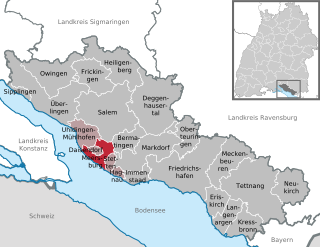
Meersburg is a town in Baden-Württemberg in the southwest of Germany. It is on Lake Constance.
Richard Ansdell was a British painter of animals and genre scenes.

Friedrich Gauermann was an Austrian painter. The son of the landscape painter Jacob Gauermann (1773–1843), he was born at Miesenbach near Gutenstein in Lower Austria. He was an early representative of the Veristic style devoted to nature in all its diversity. He was born in Scheuchenstein.

Droving is the practice of walking livestock over long distances. It is a type of herding, often associated with cattle, in which case it is a cattle drive. Droving stock to market—usually on foot and often with the aid of dogs—has a very long history. An owner might entrust an agent to deliver stock to market and bring back the proceeds. There has been droving since people in cities found it necessary to source food from distant supplies.
Theodoros Vryzakis was a Greek painter, known mostly for his historical scenes. He was one of the founders of the "Munich School", composed of Greek artists who had studied in that city.

Alpine transhumance is transhumance as practiced in the Alps, that is, a seasonal droving of grazing livestock between the valleys in winter and the high mountain pastures in summer. Transhumance is a traditional practice that has shaped much of the landscape in the Alps, as without it, most areas below 2,000 m (6,600 ft) would be forests. While tourism and industry contribute today much to Alpine economy, seasonal migration to high pastures is still practiced in Bavaria, Austria, Slovenia, Italy, France and Switzerland, except in their most frequented tourist centers. In some places, cattle are taken care of by local farmer families who move to higher places. In others, this job is for herdsmen who are employees of the cooperative owning the pastures.
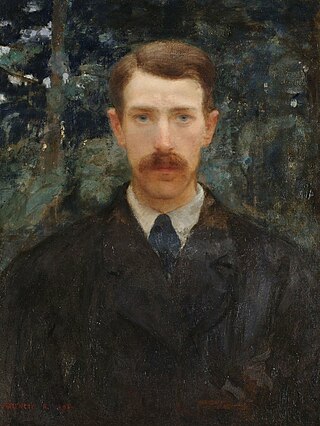
Károly Ferenczy was a Hungarian painter and leading member of the Nagybánya artists' colony.
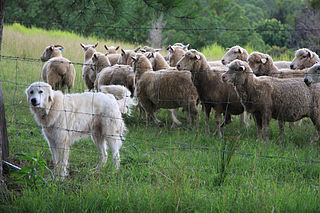
A livestock guardian dog (LGD) is a dog type bred for the purpose of protecting livestock from predators.

A shepherd is a person who tends, herds, feeds, or guards flocks of sheep. Shepherding is one of the world's oldest occupations; it exists in many parts of the globe, and it is an important part of pastoralist animal husbandry.

Rudolf Koller was a Swiss painter. He is associated with a realist and classicist style, and also with the essentially romantic Düsseldorf school of painting. Koller's style is similar to that of the realist painters Gustave Courbet and Jean-Baptiste-Camille Corot. Considered Switzerland's finest animal painter, Koller is rated alongside George Stubbs, Rosa Bonheur and Théodore Géricault. While his reputation was based on his paintings of animals, he was a sensitive and innovative artist whose well-composed works in the "plein air" tradition, including Swiss mountain landscapes, are just as finely executed.

Gottlieb Daniel Paul Weber was a German artist. Weber is known for his ethereal and timeless landscape paintings of early northeast America. He emigrated to the U.S. in 1848 and though he returned to Germany around 1860 his influence on American landscape painting was still felt for years.
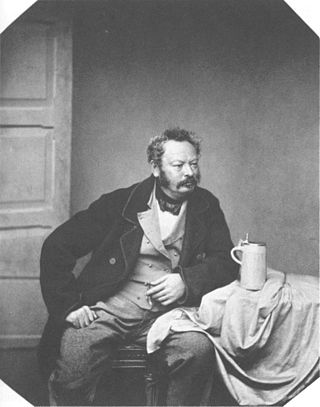
Heinrich Bürkel (1802–1869) was a German genre and landscape painter
Ralph Nicholson Wornum (1812–1877) was a British artist, art historian and administrator. He was keeper and secretary of the National Gallery of London from 1855 until his death.
Adam Eberle, one of the earliest and most gifted pupils of Peter von Cornelius, was born at Aachen in 1804. He studied painting at the Düsseldorf Academy, and afterwards went with Cornelius to Munich. After commencing his career at Düsseldorf by painting The Entombment of Christ and St. Helena with two Angels he executed the large fresco-painting on the ceiling of the Odéon, representing Apollo among the Shepherds. In 1829 he went to Rome, where he died in 1832. He is associated with the Düsseldorf school of painting.
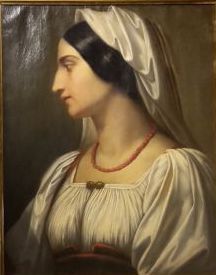
Joseph Anton Fischer (1814–1859) was a German painter born at Oberstorf, Algäu.
Charles George Lewis was a British printmaker.

Our English Coasts, also known as Strayed Sheep, is an oil-on-canvas painting by William Holman Hunt, completed in 1852. It has been held by the Tate Gallery since 1946, acquired through The Art Fund.
Victor Zelman (1877–1960) was an Australian painter and etcher. He was born in Melbourne and was the son of Alberto Zelman (senior) and the brother of Alberto Zelman, the founder of the Melbourne Symphony Orchestra.